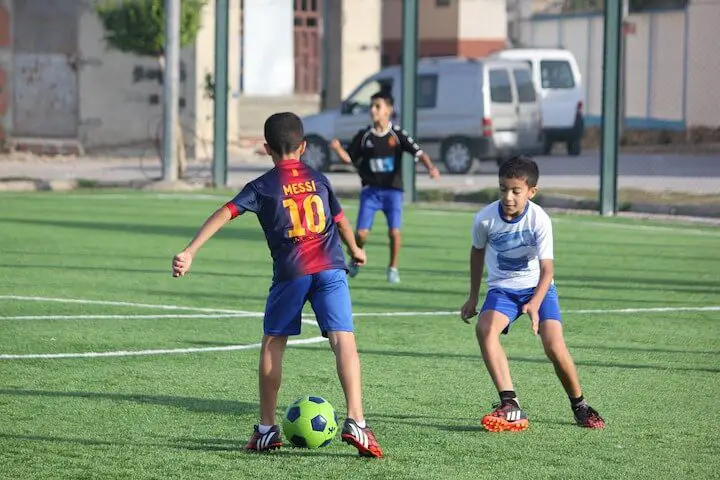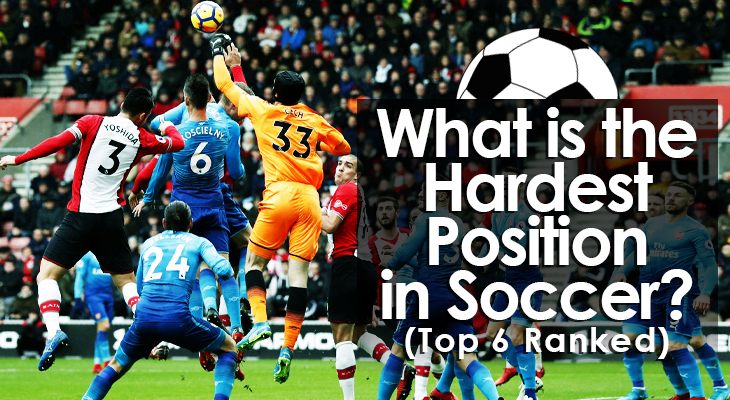What is the Hardest Position in Soccer? (Top 6 Ranked)
While anyone can take part in soccer, it’s by no means an easy sport to play competitively.
In a 11v11 contest, each position on the field has their own set of responsibilities which requires a certain skill set and competency level.
Although some players are best suited to play particular positions due to their size, physical characteristics, and skill levels, certain positions are inherently more difficult than others.
"So, what is the hardest position in soccer?"
Below, I break down the hardest positions and explore what it takes to excel in each.
Hopefully you’ll pick up some nuggets that will help you become a better player down the line.
The Hardest Position in Soccer Rankings:
#1 - Goalkeeper
It’s hard to argue that any position is more difficult than the goalkeeper.
Goalies are built differently.
They’re the only players on the field allowed to use their hands and they must do so to stop shots of all varieties from hitting the back of the net.
Goalkeepers must be athletic, agile, and have quick reactions to block shots.
In the modern game, they also need to be good with their feet. Keepers of today are very much involved in build-up play, frequently receiving the ball and playing passes.
At the highest level, teams no longer simply look for the "best shot"-stoppers to play in goal.
Instead, they seek out solid goalies with great distribution and good on-the-ball skills.
There is pressure in every action a goalkeeper takes.
As the last line of defense, a single mistake from the number 1 can have game-altering consequences.
Faced with unique responsibilities and more pressure than any other player, the goalkeeper the hardest position in soccer.
#2 - Striker
From the outside, it may seem like the striker has it easy.
They stay high up the field, shoot at every opportunity, and get all the headlines when they score the winner.
Although these are some of the roles of a striker, they barely scratch the surface in terms of their overall responsibilities.
Strikers bear the heaviest goal-scoring burden for their teams.
Alongside stopping them, scoring goals is the hardest part of soccer.
Competing against big center backs and feisty defenders, strikers are always outnumbered.
They must develop a good understanding of the game and learn the art of movement to get themselves into good positions.
When the ball eventually comes their way, strikers need to be clinical.
In high-pressure moments with defenders chasing you down, finishing calmly is a skill that takes years of practice to master.
More often than not, strikers are the best technical players on their teams.
They leverage their abilities in every game to gain inches on their opponents.
In addition to fundamentals, strikers must have bulletproof minds and supreme confidence. Even when they’re in a funk, the best forwards ignore their form and focus on taking the next chance.
All these make the striker one of the hardest positions in soccer.
#3 - Center Attacking Midfielder
Center attacking midfielders (CAMs) are at the heart of any team’s offense.
It’s a position that requires elite technical skills, vision, and at times, a dash of genius.
Some of the world’s best players assume this role, such as Lionel Messi, Kevin De Bruyne, and Bruno Fernandes.
Using pin-point passing, high-level dribbling, and intelligence, CAMs are the keys to unlocking a rigid defense.
Although they play between the opposition’s lines of midfield and defense, they frequently receive the ball with their back to the goal in congested areas.
They must have top-tier positional sense and know exactly what’s going on around them.
Statistically, CAMs turn over possession more than any other position.
This is a reflection of just how difficult this role is.
Attacking midfielders find pockets of space to pick up possession, then immediately look to instigate attacks with probing passes and direct runs.
They rely on their quality to eventually make a breakthrough in the final third.
In general, CAMs get judged on the number of goals and assists they provide in a season.
So, the pressure to perform never ceases.
#4 - Deep-Lying Playmaker
A deep-lying playmaker is a variation of a defensive midfielder.
Rather than just breaking up attacks and shielding the defense, they also have the responsibility to dictate tempo and pull the strings from defensive areas.
To excel in the role, players must have a unique skill set.
In addition to having strong defensive fundamentals and good all-around technique, these midfielders must also be skilled playmakers.
Great vision allows them to see forward passes and spot attackers’ runs.
However, vision and imagination aren’t enough...
Deep-lying playmakers need to be able to execute.
Playing in this position requires a broad passing range, flawless striking technique, and quick decision-making.
Line-breaking passes, cross-field switches, and well-timed through balls are staples of an elite playmaker.
Most soccer fans agree that Andrea Pirlo was the best to ever do it. Some of the great modern-day deep-lying playmakers include Toni Kroos, Marco Veratti, and Rodri.

#5 - Winger
In terms of individual roles, winger might be the hardest position in soccer.
These wide playmakers frequently find themselves in 1v1 situations against tough defenders.
In addition to beating their marker with skill and pace, wingers must be able to deliver in the final third with accurate crosses, precision passing, and dangerous cutbacks.
Wingers are usually the most skillful players on their teams.
They’re relied upon to use neat footwork and trickery to ghost past defenders and create goalscoring opportunities.
Every game is an individual battle as they try to get the better of their opponent.
Naturally, you won’t beat your marker every time, so wingers must be resilient and persistent even when things aren’t going their way.
Their role has become even more challenging in recent years as wingers are now responsible for contributing a significant portion of goals and assists for their teams.
Playing on the wings is hard work and there is no room for coasting.
#6 - Center Back
Center backs are the enforcers of the backline.
Operating as a duo or trio, they’re responsible for stopping all central threats and preventing strikers from scoring.
Center backs are tough-tackling, no-nonsense types who never give an inch.
One of the key attributes of a dominant center back is heading, which requires strength, timing, and leaping abilities.
Facing up against fast, skillful, and powerful strikers in every game, center backs must have excellent positioning. They learn to read the game, pick up on tendencies, and anticipate where any danger is coming from.
The best defenders are proactive rather than reactive, ensuring they deal with issues long before they become chances.
In fact, top center backs often make defending look easy as they’re always in the right place at the right time.
Center backs are sometimes referred to as the on-field coaches.
Sitting deep with the entire field ahead of them, they’re perfectly positioned to guide and instruct their teammates.
Leadership and communication are must-have skills of any top center back.
Conclusion
In soccer, no position is easy.
Depending on your playing style, you may be more effective in certain areas of the field.
And keep in mind that the difficulty level of a certain position comes down to the opponent.
Regardless of where your coach puts you, you owe a responsibility to give your best.
I recommend you don't worry about what is and what isn't the hardest position.
Instead, gain a deeper understanding of the requirements in each position, and then you’ll be more of an asset to your side.
I hope this guide provides you with insight that you can apply directly to your game.

